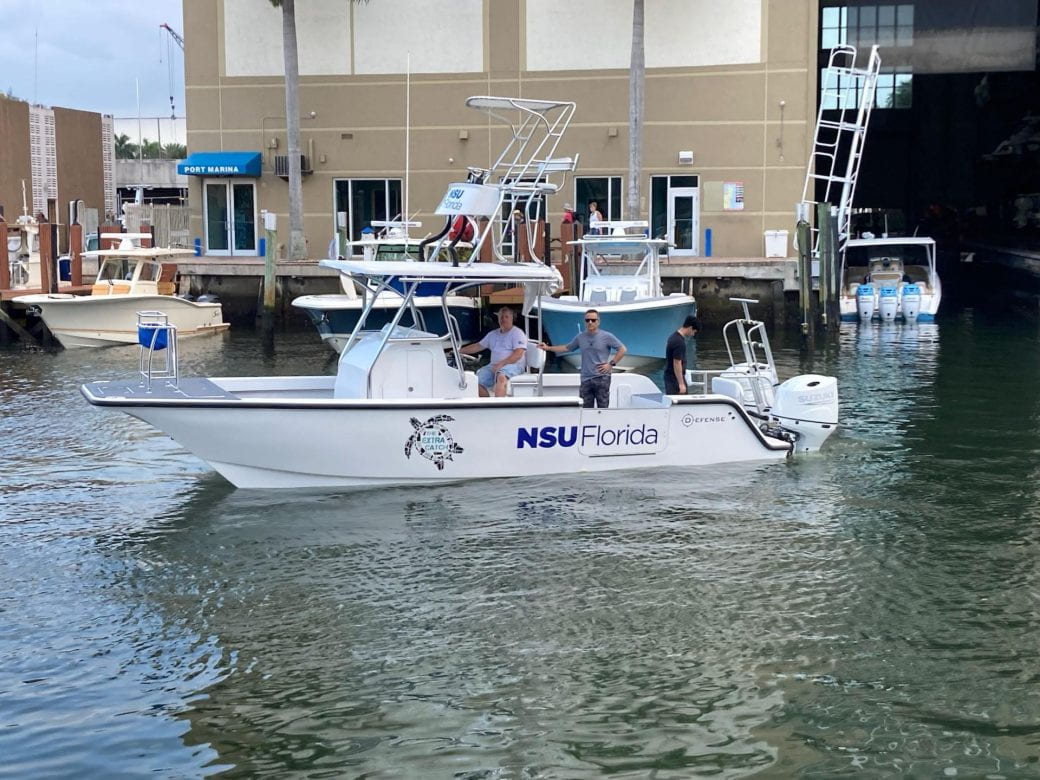Named after an organization with a mission to clean up the world’s oceans, The Extra Catch is a dream research vessel turned into reality for Derek Burkholder, Ph.D. The catamaran came to fruition thanks to the efforts of the Hooley-Zimmerman and Hudson families.
Burkholder serves as the director of the Marine Environmental Education Center (MEEC), research scientist with the Guy Harvey Research Institute and Save Our Seas Shark Center, as well as the principal investigator for the Broward Sea Turtle Conservation Program. In addition, he has mentored high school students, including Conor Zimmerman, who founded The Extra Catch organization after being disturbed by the amount of trash he found in the ocean while working on a research project with Burkholder.
“I’ve been very fortunate to work with Patty Hooley, Kurt Zimmerman, and their family,” Burkholder said. “The kids have done internships over the years and are all involved in The Extra Catch. I’ve been very fortunate to work alongside that program and watch as the students have taken it on and really grown it. While talking to Patty one day, I mentioned I would love to get a boat for my lab to be able to expand the research I’m doing. Luckily, she grabbed on to that, loved the idea, and went to work. When she talked with Steve Hudson and his family, they decided to put the funds together to build my dream research vessel.”
The 28-foot catamaran was designed with research in mind, especially for projects that involve studying sea turtles. The boat is wide, allowing for more people to be on board working. Because it’s a catamaran, it maneuvers well in low water. The addition of jack plates to raise the motors allows the boat to forge ahead in even shallower water, which Burkholder says is necessary when trying to reach the turtles.
A tower with a second driving station on top means researchers can be above the glare of the water and spot swimming turtles. For those waiting below to jump in the water with the turtles, the boat was equipped with rails and leaning posts, so people have something to hang on to and not fall off. Finally, the boat includes a wide door in the side of the boat so turtles can be brought onto the vessel at almost water level—beneficial when the animal weighs several hundred pounds.
“We were able to customize the boat in a number of different ways to make the work as efficient as possible,” Burkholder said. “When we’re trying to catch turtles in the ocean, we drive around until we find one. Then we chase it until somebody jumps off the front of the boat at hopefully the right time, grabs the turtle, and brings it up to the surface so we can bring it onto the boat. It’s very exciting and very crazy to chase a turtle that’s doing everything in its power to not let you stay close to it.”
The Extra Catch will be used to continue a study to understand the movements and habitat use of sea turtles in Biscayne Bay. The project is a collaboration with the U.S. Geographical Survey (USGS), and the team had previously used a USGS boat to conduct research. That all changed when the pandemic caused restrictions in government policies.
“We’d been working on that project for several years, but when COVID hit, USGS shut down all operations for anyone who wasn’t a USGS employee. Even though we had joint grant, for a year and a half, I wasn’t able to go into the field to work on my own project because I couldn’t get on their boats.”
With The Extra Catch vessel on the water, teams from both NSU and USGS can now conduct research, increasing the information discovered and the impact of the study. Burkholder plans to expand this research into the Florida Keys and Dry Tortugas.
The boat will also be used for shark research. Currently, data is only collected as part of the Guy Harvey Research Institute’s shark tagging awareness research program. Opportunities to collect shark data were only created when school groups signed up to participate in the tagging and a dive boat could be rented. Burkholder is excited to get a better sampling that isn’t limited by a tour group calendar or specific area.
Burkholder is also grateful for the opportunities this gift will provide for the NSU community. Graduate students will be able to create additional projects and studies to better understand sea turtles, sharks, and their interactions with marine communities. NSU will also be able to offer undergraduate students the chance to get out on the water through courses that did not previously have access to a vessel.
“I hope the Zimmermans and Hudsons understand how much this boat is going to have an impact on the work we do at NSU. The biggest thing I can say about any of our donors is just how much of an impact they have. I have been a very fortunate recipient of donations through the sea turtle program, through the shark research program, through the MEEC, and through this boat, and it’s amazing how far we can stretch these dollars and how much can really be done. At NSU and in these programs, that is just immeasurable,” Burkholder said.
“I think that’s my biggest thank you and biggest shout-out to any of the donors, all the donors—what they give allows us to do what we do,” he added. “
To have people support me, the NSU community, and our students like this just blows me away. It really does make that dream of being able to expand the work and impact of the research come true.”
For more information on how to support the MEEC and research programs at the Halmos College of Arts and Sciences, contact Diane Klein, director of development, at (954) 262-2171 or via email at kdiane@nova.edu.

